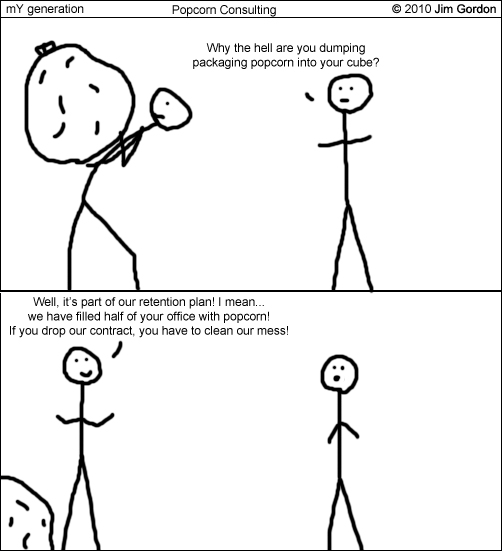|
|
|
Archive for September, 2010
Tuesday, September 21st, 2010
 Companies struggle not only to create great corporate cultures, but to describe them. Perhaps they should read more ads, because off and on I see ads that do a great job of describing various parts of corporate culture. Companies struggle not only to create great corporate cultures, but to describe them. Perhaps they should read more ads, because off and on I see ads that do a great job of describing various parts of corporate culture.
For instance, in 1998 Sun Microsystems ran an ad that said, “Information shall circulate as freely as office gossip.” A great attitude for any company or manager.
Today I saw another that embodies another great corporate culture action; it was run by IDA Ireland in Business Week.
“New thinking is not about the dollars you invest. It’s about the people you invest in.”
That attitude is even more important today, in a world of shrinking budgets, than it was before tough times hit.
It’s simple; if you want to keep your valuable assets, AKA, the people who keep your company/department/team running smoothly then they need to feel that staying is smarter than leaving.
They need to feel valued even when there’s no money for raises and bonuses.
You do that by investing in them and helping them grow.
And you can do it even when your training budget has been slashed to the bone.
Funnily, I wrote about exactly that way back in 2006.
Worked then, works now.
Flickr image credit: http://www.flickr.com/photos/zedbee/103147140/
Posted in Culture, Ducks In A Row, Motivation | No Comments »
Monday, September 20th, 2010

Saturday I said, “It’s innovation, no matter where it’s done, and MAP that drives jobs,” and that I would expand on MAP’s role today.
Ask people what an entrepreneur does and their description will usually say something about starting a company.
But there is a critical psychological difference between entrepreneurs that has nothing to do with investment, revenue or even employees.
- It’s the difference between creating a company and being self-employed—even if you have 50 employees and $50 M revenue.
- It’s the difference between trusting others and what those in the startup world call founder ego—the belief that you can do any job better than anyone you hire.
- It’s the difference between making yourself central to every action and decision within the company or hiring well, delegating and then getting out of the way, so people can do their jobs.
- Simply put, it’s the difference between holding on and letting go.
And it is that difference that often decides not just the company’s success, but whether the founder sticks around or leaves—willingly or with help from the board/investors.
Flickr image credit: http://www.flickr.com/photos/helga/3436664563/
Posted in Business info, Innovation | 1 Comment »
Sunday, September 19th, 2010
See all mY generation posts here.

Posted in mY generation | No Comments »
Sunday, September 19th, 2010

Are you familiar with the multi-talented Samuel Johnson, “a British author who made lasting contributions to English literature as a poet, essayist, moralist, literary critic, biographer, editor and lexicographer?”
His commentary is extensive and touches many subjects; the ones I’m sharing today have great applicability to modern business.
Have you ever wondered why you are willing to trust a stranger or a newcomer more than a known quantity? Johnson offered excellent insight on that attitude when he said, “We are inclined to believe those whom we do not know because they have never deceived us.”
Of course, he also points out that “Man’s chief merit consists in resisting the impulses of his nature,” which fewer and fewer seem to do.
Millions of people today are too lazy or busy to think for themselves, so they base their integrity on ideology instead of knowledge. But as Johnson points out, “Integrity without knowledge is weak and useless, and knowledge without integrity is dangerous and dreadful.”
People of all ages, but especially younger ones, look for shortcuts to achieve their goals, but Johnson understood that shortcuts don’t accomplish what we want, “What we hope ever to do with ease, we must learn first to do with diligence.”
The next two quotes point to his understanding of those who would innovate.
He said, “Curiosity is one of the permanent and certain characteristics of a vigorous mind.”
It is often curiosity that leads to new approaches and ideas; Johnson also knew that trying to respond to objections was one of the greatest roadblocks to creating something new—“Nothing will ever be attempted if all possible objections must first be overcome.”
But I think he drops the ball of entrepreneurship with these words, “He is no wise man that will quit a certainty for an uncertainty.”
If that were true, then history’s innovators, both great and small, have no claim to wisdom.
Finally, for all those who manage or parent or just interface, take to heart these words of wisdom “People need to be reminded more often than they need to be instructed.”
How true.
Image credit: http://www.flickr.com/photos/merlin/124294460/
Posted in Quotable Quotes | No Comments »
Saturday, September 18th, 2010

Lots of talk out there that small biz and startups are the best job engine, but is that true?
But research published last month by three economists, working with more recent and detailed data sets than before, has found that once the age of the businesses is taken into account, there is no difference in the job-producing performance of small companies and big ones.
Intel’s Andy Grove doesn’t buy the small biz story, either.
The former Intel chief says “job-centric” leadership and incentives are needed to expand U.S. domestic employment again.
It’s innovation, no matter where it’s done, and MAP (more on this Monday) that drives jobs.
So what’s up in innovation? Here’s a global look at what’s hot.
Each year the World Economic Forum recognizes small companies whose innovations could help change the world. This year’s crop is the most diverse ever.
Next is a truly fascinating glimpse of how a repositioned process could turn manufacturing on its head, since off shoring would offer no gains, just higher costs.
Advocates of the technology say that by doing away with manual labor, 3-D printing could revamp the economics of manufacturing and revive American industry as creativity and ingenuity replace labor costs as the main concern around a variety of goods.
There is an abundance of information that addresses questions on what entrepreneurism really involves and what it takes to be an entrepreneur.
MIT hosted Startup Bootcamp to provide a diverse group of lessons to hopeful founders and those teetering on the edge of jumping into a startup.
If this intrigues you, be sure to read Jason Baptiste’s summary on StartUps.com.
Flickr image credit: http://www.flickr.com/photos/pedroelcarvalho/2812091311/
Posted in Entrepreneurs, Expand Your Mind | No Comments »
Friday, September 17th, 2010
 I have said in the past that, based on my experience, the workforce breaks down into three segments. I have said in the past that, based on my experience, the workforce breaks down into three segments.
-
-
- At the top you have the 10% who succeed on their own no matter what;
- at the other end are the 3% I call destroyers—because that’s how they get their kicks; the other
- 87% are neither stars nor destroyers on their own, but can become either based on the way they are managed.
Hold that thought.
I recently read about a large cat that mimics its prey as part of its mealtime strategy.
And then Dr. Calleia saw, to his astonishment, that the cries weren’t coming from a tamarin pup, but rather from a margay, an ocelotlike cat with large eyes, large paws and a large appetite for monkey meat.
Back to the thought you are holding.
The action of the margay reminded me how some destroyers (see above) will mimic good management or team attitudes to attract their pray.
But how can you tell? Work is difficult enough without wondering if your team members or managers are part of the 3%.
It’s not as difficult as you might think, because you can feel them.
Destroyers feel hollow, the same difference between tapping a wall on the stud vs. on the sheetrock. The difference is that you feel with all five senses, not just your ears.
You pick up on a delay factor—their smiles don’t hit their lips and eyes at the same time, laughter is always a second or two late, as are their congratulations.
Most of us have met destroyers at some point in your life, whether at work or elsewhere.
You don’t have to focus on looking for these signs, you just need to be open to your feelings and not ignore them when they happen.
You may get an occasional false positive, but that’s better than ignoring your feelings and getting walloped.
Flickr image credit: http://www.flickr.com/photos/malias/97934221/
Posted in Business info, Retention | No Comments »
Thursday, September 16th, 2010
 Work hard, work smart, climb the corporate ladder, get tight with the right people and you could grab the brass ring—a director’s seat on one (or more) boards. Work hard, work smart, climb the corporate ladder, get tight with the right people and you could grab the brass ring—a director’s seat on one (or more) boards.
Money, prestige, power, respect—the hallmarks of leadership.
Responsibility—lots of it, especially if you are an outside director.
Accountability—not so much.
Consequences—rarely if at all.
Most of the outside directors serving on boards for companies such as AIG, Bear Sterns and Lehman Bros. moved almost immediately to other boards.
No muss, no fuss, no accountability, no consequences.
“In too many cases, the radioactivity of a board member of a collapsed company has a half life measured in milliseconds,” said John Gillespie, a longtime Wall Street investment banker and the co-author of “Money for Nothing” (Free Press), a recent book on corporate boards.
Rakesh Khurana, a Harvard Business School professor specializing in corporate-governance issues, says there are legitimate questions surrounding these boards. “When selecting individuals to oversee an organization, what criteria should we be using other than their previous performance on a corporate board?” he said. “If there’s no accountability here, then what is the system of accountability?”
Makes you wonder exactly what “fiduciary responsibility” means these days—let alone what it takes to breach it.
stock.xchng image credit: http://www.sxc.hu/photo/683292
Posted in Leadership's Future | No Comments »
Wednesday, September 15th, 2010
Posted in Wordless Wednesday | No Comments »
Tuesday, September 14th, 2010

Good culture empowers employees, juices creativity, sparks innovation and powers productivity, while bad culture kills them.
Not just lowers or slows them, but kills them dead.
Bad culture kills by instilling fear, stoking mistrust, destroying teams and building silos.
Bad culture always kills the messenger.
The seeds of bad culture are found in your MAP (mindset, attitude, philosophy™) and produce a toxic culture when they grow.
But weeds can be pulled and seeds kept from sprouting.
It’s your choice—it’s always your choice.
Flickr image credit: http://www.flickr.com/photos/zedbee/103147140/
Posted in Culture, Ducks In A Row | 1 Comment »
Monday, September 13th, 2010
 Do you work at fostering a culture of innovation? Encourage your people to think creatively? Do you want them to come up with ideas, large and small, to improve products and processes? Do you work at fostering a culture of innovation? Encourage your people to think creatively? Do you want them to come up with ideas, large and small, to improve products and processes?
Most managers do.
Do you unintentionally stomp on their creative efforts?
That happens more often than you might think.
How many times has a member of your team (at any level) had an idea or made a suggestion and your initial response was along the lines of, “I know…,” “we tried that already…,” or “Jill already…”
Such reactions dump ice water on the creative process and if it happens several times most people won’t bother mentioning their next idea. Employees understand ideas may not be used, but that’s different from feeling you don’t want to hear about them unless they are perfect.
This happens most frequently with new employees, because they have no history to guide them, but new or not, the result is to kill creativity, instead of nurturing it.
I frequently hear from clients and others about their exciting breakthroughs/ideas for motivating their people, for their culture, or whatever, and it’s often simply their rephrasing of ideas we’ve been discussing or that I, or others, have written about, sometimes for years.
It doesn’t matter; and I make sure not to say anything that detracts from their breakthrough—causing them to feel that it’s not a big deal and that they merely reinvented an old wheel.
You see, the big deal is that they thought of it independently and that’s what I want to encourage—ideas, creative thinking, thinking beyond their knowledge, not necessarily historical knowledge.
To nurture the thinking that leads to creativity you need to acknowledge it, you don’t need to convince them that no one ever thought of it before, they’ll figure that out for themselves or a peer will tell them, what you focus on is the accomplishment.
The critical point is that they came to it on their own, and, because it came from inside, they own it.
And that makes the idea far more potent than anything you or I or anybody can say from the outside.
So when that old idea comes up yet again acknowledge the creativity of the thought first, then gently explain its history, being sure the person understands that the value is in the creativity it took to think of it and that you are looking forward to more creativity in the future.
Stock.xchng image credit: http://www.sxc.hu/photo/1156284
Posted in Business info, Culture, Motivation | 1 Comment »
|
 Subscribe to
Subscribe to
MAPping Company Success
About Miki 
Clarify your exec summary, website, etc.
Have a quick question or just want to chat? Feel free to write or call me at 360.335.8054
The 12 Ingredients of a Fillable Req
CheatSheet for InterviewERS
CheatSheet for InterviewEEs™
Give your mind a rest. Here are 4 quick ways to get rid of kinks, break a logjam or juice your creativity!
Creative mousing
Bubblewrap!
Animal innovation
Brain teaser
The latest disaster is here at home; donate to the East Coast recovery efforts now!
Text REDCROSS to 90999 to make a $10 donation or call 00.733.2767. $10 really really does make a difference and you'll never miss it.
And always donate what you can whenever you can
The following accept cash and in-kind donations: Doctors Without Borders, UNICEF, Red Cross, World Food Program, Save the Children
*/
?>About Miki
About KG
Clarify your exec summary, website, marketing collateral, etc.
Have a question or just want to chat @ no cost? Feel free to write
Download useful assistance now.
Entrepreneurs face difficulties that are hard for most people to imagine, let alone understand. You can find anonymous help and connections that do understand at 7 cups of tea.
Crises never end.
$10 really does make a difference and you’ll never miss it,
while $10 a month has exponential power.
Always donate what you can whenever you can.
The following accept cash and in-kind donations:
|
 Companies struggle not only to create great corporate cultures, but to describe them. Perhaps they should read more ads, because off and on I see ads that do a great job of describing various parts of corporate culture.
Companies struggle not only to create great corporate cultures, but to describe them. Perhaps they should read more ads, because off and on I see ads that do a great job of describing various parts of corporate culture.







 I have said in the past that, based on my experience, the workforce breaks down into three segments.
I have said in the past that, based on my experience, the workforce breaks down into three segments. Work hard, work smart, climb the corporate ladder, get tight with the right people and you could grab the brass ring—a director’s seat on one (or more) boards.
Work hard, work smart, climb the corporate ladder, get tight with the right people and you could grab the brass ring—a director’s seat on one (or more) boards.
 Do you work at fostering a culture of innovation? Encourage your people to think creatively? Do you want them to come up with ideas, large and small, to improve products and processes?
Do you work at fostering a culture of innovation? Encourage your people to think creatively? Do you want them to come up with ideas, large and small, to improve products and processes?
